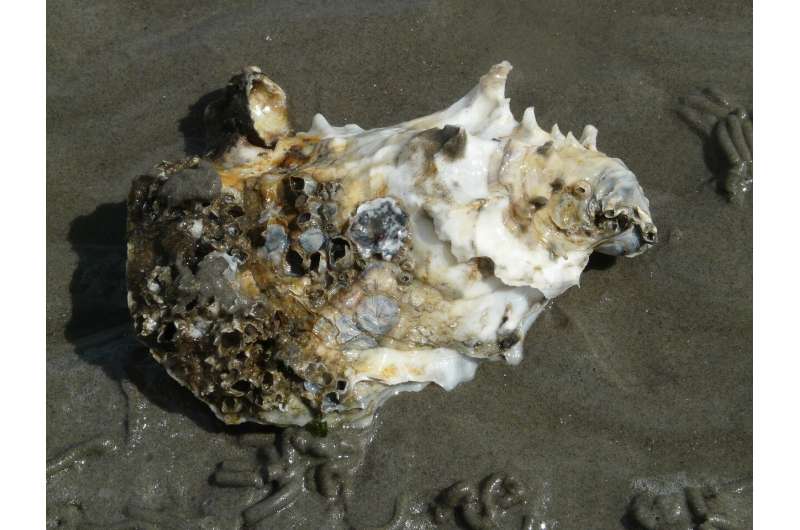Environmental groups welcome volunteers back to oyster planting in Baltimore Harbor

Sunday, for the first time since the coronavirus pandemic began, volunteers made their way to Baltimore's Downtown Sailing Center for a day of oyster gardening.
College students and retirees alike converged on the docks to build wire cages to house baby oysters, which appeared as tiny dots on thick gray shells.
One by one, the cages full of shells were plopped into the water, fastened to cleats along the edges of the docks. To the tune of the Eagles' "Hotel California" played by a young band at a benefit concert close by, the cages began their stay in the Chesapeake Bay.
And hotels they will be.
The nascent oysters—known as spat—will stay in their cages only until June. Then, they'll be transported to their forever home—the reefs of the oyster sanctuary at Fort Carroll, an artificial island in the Patapsco River south of Dundalk.
The program, called the Greater Baltimore Oyster Partnership, is a collaboration between the Waterfront Partnership's Healthy Harbor Initiative and the Chesapeake Bay Foundation, and has a goal of growing about a quarter of a million oysters in the harbor over the next 10 months.
The next groups of cages will be placed in the Lighthouse Point Marina and the National Aquarium waterfront, said Adam Lindquist, director of the Waterfront Partnership's Healthy Harbor Initiative.
"When we started this program, people said we were crazy, and that the oysters weren't going to survive," he said. "And here we are eight years later, still growing oysters in the Baltimore Harbor."
Affixed to each cage is a slight caveat: "These oysters are helping save the bay. Not for sale or consumption."
Once they're older, the oysters will become powerful filters for the bay. One oyster is capable of filtering 50 gallons of water a day, and storing harmful pollutants like phosphorous and nitrogen in its shell and tissue.
Oyster reefs also provide valuable habitats for other life forms—from tiny mud crabs to worms and grass shrimp.
For Vaiju Raja, a 23-year-old graduate student from Washington, D.C., who volunteered Sunday, it all started with a Vox video about the boon of oyster reefs.
"I have an interest in climate change and ecological restoration in general," she said. "I clicked on the video and I learned how important oysters are."
So, she found an event Saturday at the Maryland Oyster Restoration Center in Shady Side, but it was geared toward homeowners with private docks interested in cultivating oysters. Sunday, she was able to plant the oysters herself.
"I'm glad that there's a public location and public service for us," she said.
Providing access to oyster gardening and education is one of the main goals of the program, said Doug Myers, Maryland senior scientist for the Chesapeake Bay Foundation.
"This is a great environmental justice project, because we're allowing access for folks who normally don't have access to the bay," Myers said.
Susan McCardle of Locust Point said she discovered oyster gardening at her daughter Quinn's second grade field trip to the Chesapeake Bay Foundation a few years back.
"We got totally addicted to it," she said.
Together, mother and daughter fastened clips to seal their wire box, which will protect the growing oysters from predators like blue crabs.
"Spat in the wild have like a 2% survival rate," Lindquist said. "These spat will have an 80% survival rate."
The spat were grown in a lab, and affixed to recycled oyster shells, drawn from seafood restaurants around the region. After the shells are cleaned of their cocktail sauce, they dry in the sun before they host the next round of oysters, Myers said.
"That's a really important thing, because for 150-200 years when people harvested oysters out in the bay, they never put the shells back. And the shells are the substrate on which new oysters are going to settle," Myers said.
Sunday's planting was the first such event for Micah Miles, program manager for the Healthy Harbor Initiative, and it was exciting to see a few dozen people attend.
"People are starved to get outside," she said. "People ask me, 'Do you have some volunteer events? Do you have something we can do?'"
And building the cages came with a certain sense of accomplishment, said Lutherville resident Elizabeth Miller, who added that she hopes to return to help clean the cages of barnacles and debris, soon to be a monthly ritual.
"I want to put my own name on this, like "Elizabeth's Oyster Shack," so that they know where they're staying," she said with a laugh.
©2021 The Baltimore Sun. Distributed by Tribune Content Agency, LLC.




















